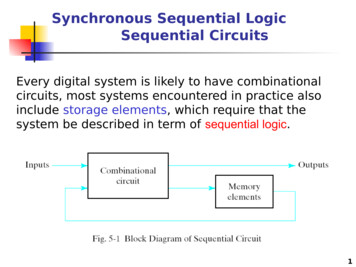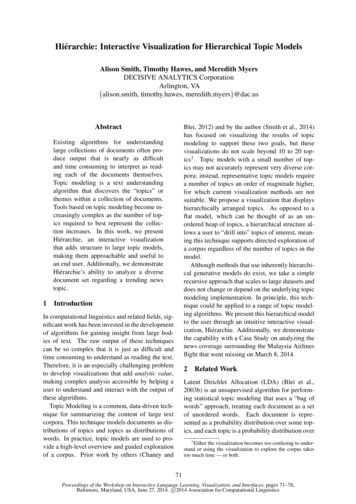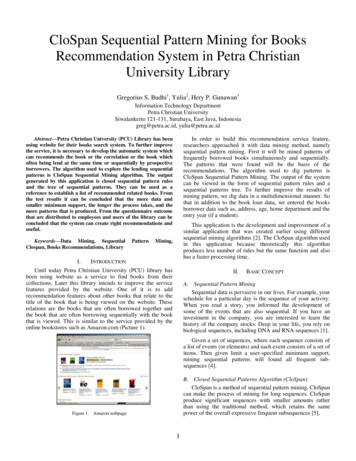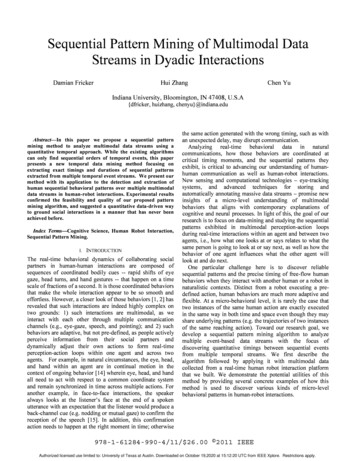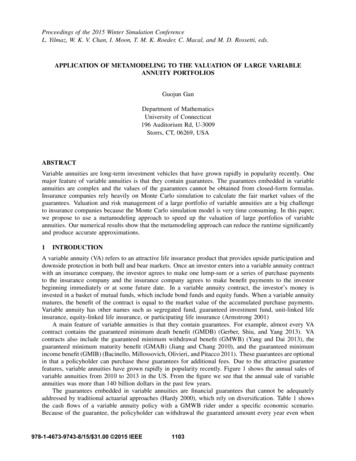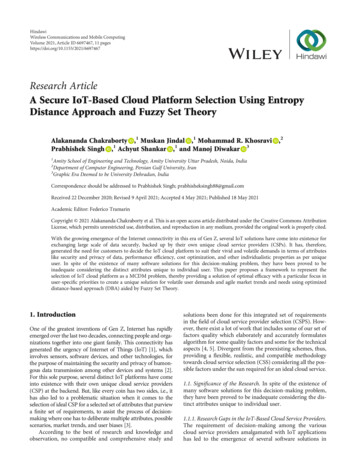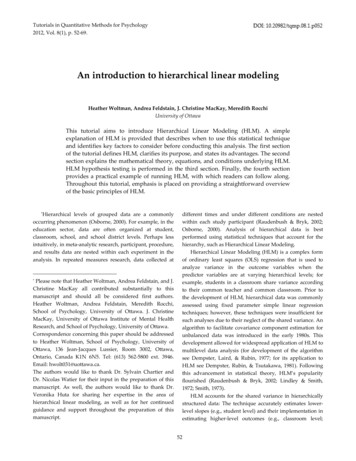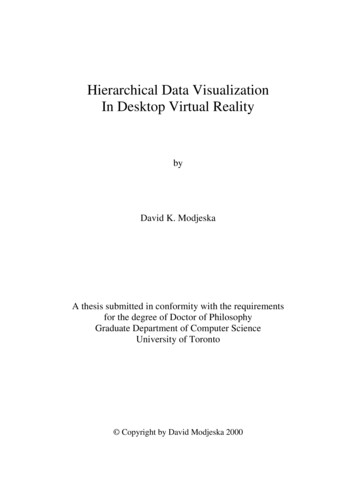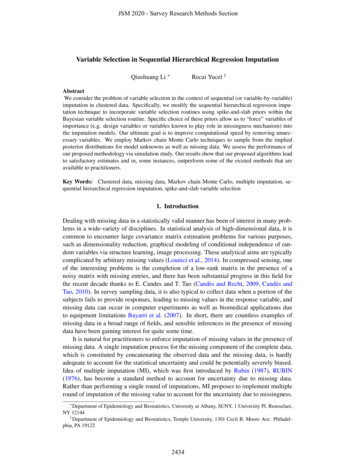
Transcription
JSM 2020 - Survey Research Methods SectionVariable Selection in Sequential Hierarchical Regression ImputationQiushuang Li Recai Yucel †AbstractWe consider the problem of variable selection in the context of sequential (or variable-by-variable)imputation in clustered data. Specifically, we modify the sequential hierarchical regression imputation technique to incorporate variable selection routines using spike-and-slab priors within theBayesian variable selection routine. Specific choice of these priors allow us to “force” variables ofimportance (e.g. design variables or variables known to play role in missingness mechanism) intothe imputation models. Our ultimate goal is to improve computational speed by removing unnecessary variables. We employ Markov chain Monte Carlo techniques to sample from the impliedposterior distributions for model unknowns as well as missing data. We assess the performance ofour proposed methodology via simulation study. Our results show that our proposed algorithms leadto satisfactory estimates and in, some instances, outperform some of the existed methods that areavailable to practitioners.Key Words: Clustered data, missing data, Markov chain Monte Carlo, multiple imputation, sequential hierarchical regression imputation, spike-and-slab variable selection1. IntroductionDealing with missing data in a statistically valid manner has been of interest in many problems in a wide-variety of disciplines. In statistical analysis of high-dimensional data, it iscommon to encounter large covariance matrix estimation problems for various purposes,such as dimensionality reduction, graphical modeling of conditional independence of random variables via structure learning, image processing. These analytical aims are typicallycomplicated by arbitrary missing values (Lounici et al., 2014). In compressed sensing, oneof the interesting problems is the completion of a low-rank matrix in the presence of anoisy matrix with missing entries, and there has been substantial progress in this field forthe recent decade thanks to E. Candes and T. Tao (Candès and Recht, 2009, Candès andTao, 2010). In survey sampling data, it is also typical to collect data when a portion of thesubjects fails to provide responses, leading to missing values in the response variable, andmissing data can occur in computer experiments as well as biomedical applications dueto equipment limitations Bayarri et al. (2007). In short, there are countless examples ofmissing data in a broad range of fields, and sensible inferences in the presence of missingdata have been gaining interest for quite some time.It is natural for practitioners to enforce imputation of missing values in the presence ofmissing data. A single imputation process for the missing component of the complete data,which is constituted by concatenating the observed data and the missing data, is hardlyadequate to account for the statistical uncertainty and could be potentially severely biased.Idea of multiple imputation (MI), which was first introduced by Rubin (1987), RUBIN(1976), has become a standard method to account for uncertainty due to missing data.Rather than performing a single round of imputations, MI proposes to implement multipleround of imputation of the missing value to account for the uncertainty due to missingness. Department of Epidemiology and Biostatistics, University at Albany, SUNY, 1 University Pl, Rensselaer,NY 12144†Department of Epidemiology and Biostatistics, Temple University, 1301 Cecil B. Moore Ave. Philadelphia, PA 191222434
JSM 2020 - Survey Research Methods SectionThe statistical analysis proceeds by treating each set of the imputed data as a set of completedata, followed by a combined analysis using Rubin’s method (Rubin, 1987, RUBIN, 1976).More specifically, the MI is built upon a complete probabilistic model for the completedata, namely, a class of joint distributions of both the observed data and the missing values,from which a simulation-based approach is implemented to perform multiple imputationfor the missing portion.The most widely adopted strategy for MI is based on Bayesian modeling. It beginswith first specifying the conditional distribution of the complete data given the unknownparameters, often referred to as the complete-data liklihood, and then a distribution forthe unknown parameters, referred to as prior distributions. This is followed by a posteriorcomputation via a Markov chain Monte Carlo sampler that draws random samples from theposterior distribution of the unknown parameters as well as the missing portion of the datagiven the observed portion of the data. Then each of the random sample drawn from theposterior predictive distribution of the missing data serves as a single round among the MIpart of the missing data, and provide a copy of the imputed version of the complete dataavailable for combined subsequent Rubin’s analysis (RUBIN, 1976).Variable selection problem arises in regression models when the number of predictorsor covariates that are available to users exceeds the number of the true active predictors, andone aims to recover the correct set of active predictors. There has been vast literature ondeveloping frequentist methods for variable selection. Classical criterion-based approachesinclude generalized cross-validation (GCV) and the Bayesian information criterion (BIC).These methods become computationally expensive when the number of candidate predictors becomes large as they require exhaustive search of the all possible sub-models, thenumber of which grows exponentially with the number of predictors. Last decade has alsowitnessed the progress of penalized-based approaches for variable selection (Bickel et al.,2006), including the LASSO, Smoothly Clipped Absolute Deviation (SCAD) penalty (Zou,2006), and Adaptive LASSO (ALASSO) (Zou, 2006). These methods translate the problemof variable selection into convex programming problems and there has been relative mature algorithms for solving these mathematical optimization problems, greatly facilitatingthe use of penalized-likelihood methods. The challenge of these likelihood-based methods is that they require the computation of the likelihood function of the incomplete datawhen one is faced with missing responses and/or predictors. Such incomplete-data likelihood function is typically intractable to compute and involves high-dimensional integrals(Garcia et al., 2010). It is therefore computationally infeasible to enforce these classicalpenalty-based methods for variable selection in regression models with missing data.There has also been significant progress in developing Bayesian methods for variableselection. The most widely adopted method is via the spike-and-slab prior distribution(Castillo et al., 2012, 2015). In particular, Castillo et al. (2015) extensively studied thetheoretical properties for Bayesian linear regression model with fixed effects using thespike-and-slab prior distribution. Other forms of the variable selection prior include theBayesian LASSO (Park and Casella, 2008), the horseshoe prior Carvalho et al. (2010), theDirichlet-Laplace prior (Bhattacharya et al., 2015), and the spike-and-slab LASSO prior(Ročková et al., 2018, Ročková and George, 2018). This body of literature, however, focuson sparsity recovery and parameter estimation in regression models and do not considermissing data scenario as well as MI, which is the focus of this work.In this paper, we are interested in methods for variable selection in the presence ofmissing data for both continuous value responses as well as binary value responses, usinggeneralized linear mixed-effects models.In particular, our contributions are:1. The proposed method is able to simultaneously perform variable selection and multiple imputation of missing responses for continuous and binary responses via mixed-2435
JSM 2020 - Survey Research Methods Sectioneffects models. We build this based on generalized linear mixed-effects models andthe posterior inference for the unknown parameters, including variable selection, aswell as the simulation-based MI for the missing responses. For computations, we utilize a Markov chain Monte Carlo sampler. Coefficients of the underlying regressionmodels are assigned a spike-and-slab prior distribution that allows variable selectiona posteriori.2. For the classical linear model with normal errors, we derive the corresponding fullconditional distributions of all the parameters involved, together with the full conditional posterior predictive distributions of the missing variables, thanks to the standard conjugate normal model, facilitating the implementation of a computationallyaccessible Gibbs sampler.3. For the binary response variables, we consider the generalized linear mixed-effectmodel with a logit link function, also referred to as the logistic linear mixed-effectsmodel. The full conditional distribution for the linear coefficients as well as therandom-effects coefficients are not in closed-forms directly, and we borrow the parameter expansion for data augmentation (PX-DA) idea of Polson et al. (2013) byintroducing the cleverly-designed auxiliary Pólya-Gamma random variables, suchthat the full conditional distributions of the expanded set of the parameters are easilyaccessible, whereas the marginal distribution of the original (unexpanded) set of parameters is left invariant. As a consequence, we develop an easy-to-implement Gibbssampler as well.4. For the simulation-based MI via the MCMC, rather than jointly drawing a set of therandom sample from the joint predictive posterior distribution of the missing variables, we follow the idea of Yucel et al. (2018) and draw each of the missing variablesequentially via the full conditional predictive distribution of the corresponding variable, referred to as sequential hierarchical regression imputation (SHRIMP). Thefundamental idea of SHRIMP is that one first sort the missing variables by their corresponding percentages of missing portion in the increasing order, and then drawsamples from the posterior predictive distribution of the missing variables followingthis sorted order. The formal description of the SHRIMP strategy will be introducedin Section 2. The advantage of this variable-by-variable MI strategy is that it reduces the computational complexity for high-dimensional data (Yucel et al., 2018)significantly.A frequentist version for variable selection in regression models in the presence of missingdata is fully addressed in Garcia et al. (2010). The major difference is that our approachis built upon a fully Bayesian methodology that allows for parameter estimation and inference, variable selection, and the implementation of MI simultaneously via a coherentGibbs sampler, whereas Garcia et al. (2010) focused on developing easy-to-compute penalized likelihood approach and focus on the inference goal via point estimators, togetherwith some well-established theoretical properties, and MI needs to be performed separately.The rest of this paper is organized as follows. Section 2 is devoted to the linear mixedeffects regression model for variable selection with missing responses for continuous valueresponse variables, in which a Gibbs sampler is developed. For binary response variables,we elaborate the logistic mixed-effects model for the same tasks in Section 3, introduce thePólya-Gamma random variables, leverage them for the PX-DA, and successfully developa closed-form Gibbs sampler as well. These two Gibbs samplers allow simulatenous inference of the parameters and MI of the missing responses. The advantage of the proposed2436
JSM 2020 - Survey Research Methods Sectionapproach is illustrated via numerical examples in Section 4, and we conclude the paperwith a discussion in Section 5.2. Linear mixed-effects regression models with missing responsesLet us consider a linear mixed-effects model with random intercept only for continuousresponse variable yij , which has also been considered in Yucel et al. (2018):yij xTij β bi ij ,i 1, . . . , m,j 1, . . . , n,(1)i.i.d.where β Rp is the fixed-effect, b1 , . . . , bm N(0, σb2 ) are the random effects, andi.i.d. 11 , . . . , mn N(0, σe2 ) are the errors. The responses yij ’s are either observed or missing, but the missing portion can be imputed via the last cycle of the SHRIMP strategy, asis suggested in Yucel et al. (2018). Finally, xij Rp ’s are the individual-level covariatesthat can also be either observed or missing, and the missing values are sampled through theSHRIMP strategy.We develop a Gibbs sampler to draw posterior samples from the joint distribution of(β, b1 , . . . , bm , σb , σe ), as well as to draw samples of the missing data (ymis ). To selectthe variables among xij1 , . . . , xijp , we assign a spike-and-slab prior distribution, whichhas been widely applied to Bayesian variable selection (Mitchell and Beauchamp, 1988,George and McCulloch, 1993, Clyde et al., 1996, Geweke, 1996, Kuo and Mallick, 1998),is assigned to the fixed-effects coefficient βk . In the current context, if we are not certainwhether the k th variable is to be selected, then we assign the following spike-and-slab priorto βk : 0,with probability (1 w),(2)βk w, µ0 , σ0with probability w, N(µ0 , σ02 ),where w 0 is the prior probability that the kth variable xijk is selected, and with probability (1 w), βk is set to 0 so that under the prior distribution, the kth variable is notselected. The spike-and-slab prior distribution (2) can be equivalently written as(βk w, µ0 , σ0 ) (1 w)δ0 wN(µ0 , σ02 ),where δ0 , point mass at 0, is assigned a normal prior if there is a sure certainty of selection:(βk w, µ0 , σ0 ) N(µ0 , σ02 ).To reduce the effect of hyperparameters and enhance the robustness of the entire Bayesianmodel, we further assume that the hyperparameters have the following hyperprior distributions: w Beta(aw , bw ), µ0 N(0, 1), and σ 2 Inverse Gamma(1, 1). For the restof the parameters (σb2 , σe2 ), we assume the inverse-χ2 distribution for the sake of conjugacy,2 2which has also been adopted in Yucel et al. (2018): σb2 χ 2νb and σe χνe .We provide the detailed full conditional distributions that are needed for the Gibbssampler in Appendix A. Here we focus on the conditional distribution of the linear coefficients βk , k 1, 2, . . . , p. Denote the parameters θ k be the set of all parametersexcept βk : θ k (β k , σb , σe ), where β k {β1 , . . . , βp }\{βk }, and the random effects b [b1 , . . . , bm ]T . Then the full conditional distribution of βk for k 1, 2, . . . , p isgiven by(w1 δ0 w2 N(bµ, Vb ), if xijk is not required,(βk X, θ k , w, µ0 , σ0 ) (3)N(bµ, Vb ),if xijk is required,2437
JSM 2020 - Survey Research Methods Sectionwhere X denotes the full set of covariates X [xij ]i 1,.,m,j 1,.,n ,Pw1 (1 w)N0Pw2 wN µ0mi,ji,jxijk (yij P 6 k2xi,j ijkxijk (yij PnPP 6 k2i,j xijk 1xij β bi )xij β bi ), σ02σ2,P e 2i,j xijk!σ2 P e2i,j xijk,!,1 XX 21Vb 2xijk 2 ,σeσ0i 1 j 1 m XnXXµ01µb Vb 2 2xijk yij xij β bi ,σeσ0i 1 j 1 6 kThe derivation of the rest of the full conditional distributions are routine and are deferredto Appendix A. We also emphasize that (3) presents the nature of variable selection insidea single cycle of the Gibbs sampler: with probability w1 , we set βk 0, suggesting thatcurrently the kth variable xijk is not selected, and with probability w2 , we draw βk from anormal distribution, indicating that βk 6 0, and therefore, the kth variable xijk needs to beselected.For a given set of values β, σb , σe , b1 , . . . , bm that are drawn from a single cycle of theGibbs sampler, each missing response can be drawn from2(yij X, β, σb , σe , b1 , . . . , bm ) N(xTij β bi , σe ),where “j” indicates missing value(s) among the ith observational (cluster) unit. Here weadopt the SHRIMP strategy to draw the samples y(mis) given y(obs) and θ in the followingsequential fashion: Step 1: Order the column indices {1, 2, . . . , n} of the response matrix Y such thatthe sorted indices, say {j1 , . . . , jn }, satisfynX1(yijk NA) i 1nX1(yijk 1 NA),i 1i.e., the number of missing values of the jk th column is always no greater than thenumber of missing values of the jk 1 th column. Step 2: Sample {yij } where j denotes the missing data value for j th observation incluster i.The idea of the SHRIMP strategy is to impute missing values in a variable in an order defined according to the amount of missingness (from least missing to most). By iteratingthe above cycles for sufficiently large number of times, we are able to obtain a sequenceof parameters drawn from the Gibbs sampler {θ(1) , θ(2) , . . .}, which converges in distribution to {ymis(1) , ymis(2) , . . .} as the number of cycles goes to infinity, as well as a sequence of missing responses ymis {ymis(1) , ymis(2) , . . .}, whose limiting distribution isP (ymis yobs , X, b1 , . . . , bm ), where yobs denotes the observed y-values. After the Gibbssampler is completed and the Markov chain converges, we sample ymis from its predictivedistribution with the final set of drawn values of all the parameters. For the purpose ofmultiple imputation, one can repeat this procedure for M times to obtain M copies of theimputed data.2438
JSM 2020 - Survey Research Methods Section3. Logistic mixed-effects regression models with missing responsesWe assume that our binary variable follows a logistic mixed-effects regression model:P (yij 1 xij , bi , β) 1,1 exp( xTij β bi )i.i.d.where β are the fixed-effects coefficients for covariates xi , and b1 , . . . , bm N(0, σb2 ) arethe random effects. To develop a closed-form Gibbs sampler for the logistic regressionmodel with respect to the random-effects, we adopt a similar strategy suggested by Polsonet al. (2013). They suggest introducing a collection of auxiliary variables following thePólya-Gamma distribution, such that the full conditional distributions of all parametersare obtainable in closed-form. Before understanding the mechanism, we first present thedefinition of the Pólya-Gamma distribution (see Definition 1 in Polson et al., 2013): Arandom variable X is said to follow a Pólya-Gamma distribution with parameters b 0and c R, denoted by X PG(b, c), if there exists a sequence of independent Gammai.i.d.random variables (gk ) k 1 Gamma(b, 1), such thatX 1 Xgk.2π 2(k 1/2)2 c2 /(4π 2 )k 1The key result of the Pólya-Gamma distribution lies in the following theorem, which isestablished in Polson et al. (2013):Theorem 1 (Theorem 1 in Polson et al., 2013) Let p(ω) be the density function of ω PG(b, 0), b 0. Then the following integral identity holds for all a R: Z [exp(ψ)]ab1 2 b 2 exp a ψexp ωψ p(ω)dω.22[1 exp(ψ)]b0Moreover, the normalized integrand exp ωψ 2 /2 p(ω)p(ω ψ) R 20 exp ( ωψ /2) p(ω)dωis the density function of ω PG(b, ψ).We let the following prior distributions reflect the appropriate prior knowledge on thefixed-effects coefficients β1 , . . . , βp . In light of the need for variable selection, we assignthe spike-and-slab prior (2) to β1 , . . . , βp as follows(βk w, µ0 , σ02 ) (1 w)δ0 wN(µ0 , σ02 ),(βk w, µ0 , σ02 ) N(µ0 , σ02 ),w Beta(aw , bw ),if the kth variable is undetermined,if the kth variable is forced to be selected,µ0 N(0, 1),(4)σ 2 IG(1, 1).The prior distribution on σb is same as Section 2: σb2 χ 2νb .We now elaborate on the full conditional distributions of the linear coefficients βk , k 1, 2, . . . , p. The rest of the full conditional distributions necessary for deriving the Gibbssampler that draws posterior samples from the joint distribution of (β, b1 , . . . , bm ), togetherwith the samples of the missing data (ymis ), are provided in Appendix B. Following thederivation in Polson et al. (2013), we utilize Theorem 1 and derive the likelihood functionof ηij : xTij β bi! Z 2ωij ηij1L(ηij yij ) exp yij ηijexp p(ωij 1, 0)dωij ,2202439
JSM 2020 - Survey Research Methods Sectionwhere p(ωij 1, 0) is the density of an auxiliary Pólya-Gamma random variable ωij PG(1, 0). The idea of introducing the auxiliary variables ωij ’s is such that after marginalizing them out, the joint distribution of the rest variables is left invariant. We derive thelikelihood of β for all mn data points after introducing Ω [ωij ]m n : 12T 1L(β X, Y, Ω, b1 , . . . , bm , σ ) exp (z Xβ) Σ (z Xβ) ,2where zij (yij 1/2)/ωij bi ,z [z11 , . . . , z1n , z21 , . . . , z2n , . . . , zm1 , . . . , zmn ]T Rmn ,X [x11 , . . . , x1n , x21 , . . . , x2n , . . . , xm1 , . . . , xmn ]T Rmn p ,Σ 1 diag(ω11 , . . . , ω1n , ω21 , . . . , ω2n , . . . , ωm1 , . . . , ωmn ) Rmn mn .We then obtain the following closed-form full conditional distribution of βk , k 1, 2, . . . , p:(w1 δ0 w2 N(bµ, Vb ), if xijk is not required,(βk X, Y, Ω, β k , b, σb , w, µ0 , σ0 ) N(bµ, Vb ),if xijk is required,(5)where X denotes the full set of covariates X [xij ]i 1,.,m,j 1,.,n , and!PP1 6 k xij β )i,j ωij xijk (zij P,P,w1 (1 w)N 022i,j ωij xijki,j ωij xijk!PPxβ)ωx(z ijij1ij ijk 6 ki,jPw2 wN µ0, σ02 P,22ωxiji,ji,j ωij xijkijk 1m XnX1Vb ωij x2ijk 2 ,σ0i 1 j 1 m XnXXµ0µb Vb 2 ωij xijk zij xij β .σ0i 1 j 1 6 kThe full conditional distribution of the auxiliary variables Ω [ωij ]m n can be derivedsimilarly as that in Polson et al. (2013):(ωij β, b1 , . . . , bm ) PG(1, xTij β bi ),(6)and sampling a random variable following a Pólya-Gamma distribution can be implementedusing the algorithm described in Secion 4 in Polson et al. (2013). The derivation of the restof the full conditional distributions are similar to those in Section 2 and we leave them inAppendix B. Finally, for each missing yij (ymis ), one can draw it from the followingconditional distribution in a single cyle of the Gibbs sampler:!1.(yij X, β, b1 , . . . , bm ) Bernoulli1 exp( xTij β bi )Similar to our algorithm of Gibbs sampler in Section 2, the above procedure is performedto lead to imputed values for the binary variables (ordered from highest to lowest missingvalues) with selected as well as forced covariates. The post-MCMC analysis is the same asthat in Section 2.2440
JSM 2020 - Survey Research Methods Section4. Simulated examples4.1A linear mixed-effects regression model exampleWe begin our simulated examples with the classical linear mixed-effects regression modelwith normal errors. Our simulation proceeds for y under the following linear mixed-effectsmodel:yij xTm 1, . . . , n, j 1, . . . , n,ij β bi ij ,where (xij : i 1, . . . , n, j 1, . . . , m) are p-dimensional predictor vectors, β is thei.i.d.p-dimensional fixed-effect linear coefficients, b1 , . . . , bm N(0, σb2 ) are random effects,i.i.d.and ij N(0, σe2 ) are independent homoscedastic errors. Here we consider m 50 andj 100. The coordinates of the covariates of xij ’s are generated independently fromN(0, 32 ), and the true value of β is generated as follows: First setα [α1 , α2 , 0, 0, α3 , α4 , 0, α5 , α6 , 0],where α1 , . . . , α6 N(1, 0.12 ) independently. Then set β α/kαk2 . The responsematrix Y [yij ]m n is assumed to be contaminated by missing values, and we considertwo scenarios of missingness mechanism: Missing completely at random (MCAR): the probability for missingness of yij follows Bernoulli(0.4) independently for all i 1, . . . , m and j 1, . . . , n. Missing at random (MAR): the missingness of yij follows Bernoulli(pPp ij ) independently for all i 1, . . . , m and j 1, . . . , n, where logit(pij ) k 1 xijk /20.This results in the percentage of missingness around 20%.We then employ the Gibbs sampler developed in Section 2 for posterior inference and MI,and the number of MIs is set to M 5. For each set of the imputed data, posterior medianand standard deviation β are computed. Then we combine these estimands using Rubin’srules (RUBIN, 1976). The results are summarized in Table 1 under the MCAR and Table 2under the MAR, respectively.Table 1: Linear mixed-effects model with missing completely at random (MCAR) probability 0.4, m 50, n 100, and p 10. Imputation and estimation method is theBayesian method with the spike-and-slab (SS) prior and sequential hierarchical regressionimputation (SHRIMP). Number of multiple imputation is M 5.βTrue values Estimate Credible intervals (CI) CI width Total varianceβ10.37260.3395(0.3747, 0.3043)0.07042.4917 10 4β20.36670.3915(0.4156, 0.3675)0.04811.4139 10 4β30.00000.0000(0.0003, -0.0003)0.00051.7423 10 8β40.00000.0000(0.0012, -0.0012)0.00233.5239 10 7β50.43260.4280(0.4595, 0.3965)0.06302.0917 10 4β60.39340.3985(0.4217, 0.3752)0.04651.3361 10 4β70.00000.0000(0.0002, -0.0002)0.00041.2171 10 8β80.43700.4325(0.4690, 0.3959)0.07312.6499 10 4β90.44010.4330(0.4594, 0.4067)0.05261.6186 10 4β100.00000.0000(0.0018, -0.0018)0.00368.2747 10 7We also implement the pan package (Zhao and Schafer, 2013) and the mice(Buuren and Groothuis-Oudshoorn, 2010) package for comparison. The corresponding2441
JSM 2020 - Survey Research Methods SectionTable 2: Linear mixed-effects model with missing at random (MAR) probability 0.4, m 50, n 100, and p 10. Imputation and estimation method is the Bayesian method withthe spike-and-slab (SS) prior and sequential hierarchical regression imputation (SHRIMP).Number of multiple imputation is M 5.βTrue values Estimate Credible intervals CI width Total varianceβ10.36520.3868(0.4081, 0.3655)0.04261.1555 10 4β20.42890.4161(0.4349, 0.3973)0.03769.1991 10 5β30.00000.0000(0.0000, 0.0000)0.00000.0000β40.00000.0000(0.0000, 0.0000)0.0000 4.9048 10 13β50.39850.4027(0.4272, 0.3782)0.04891.4247 10 4β60.41650.4065(0.4256, 0.3874)0.03829.4402 10 5β70.00000.0000(0.0000, 0.0000)0.00095.6395 10 8β80.40880.3978(0.4166, 0.3791)0.03759.1407 10 5β90.42820.4224(0.4453, 0.3994)0.04591.2999 10 4β100.00000.0000(0.0000, 0.0000)0.00084.2961 10 8combined Rubin’s analysis results for the pan package are tabulated in Table 3 under theMCAR and Table 4 under the MAR, and the corresponding results for the mice packageare listed in Table 5 and Table 6 under the MCAR and MAR, respectively. The numerical results for the three approaches under the MCAR and the MAR are also visualized inFigure 1 and Figure 2, respectively. From both the tables and the plots, one can identifythat the pan package can estimate β well but is unable to detect the sparsity pattern ofβ, and hence is not successful in variable selection; It can also be seen that for the micepackage, it is unable to estimate β accurately, losses the coverage of the confidence intervals for β, and is not successful in variable selection. On the contrary, we can see thatthe proposed approach outperforms some of the alternatives (e.g., the pan package andthe mice package) in terms of both accuracy for estimating the regression coefficient β,detecting the sparsity pattern of β, and uncertainty quantification assessed by the width ofthe confidence intervals.Table 3: Linear mixed-effects model with missing completely at random (MCAR) probability 0.4, m 50, n 100, and p 10. Imputation and estimation method is the panpackage. Number of multiple imputation is M 5.βTrue values Estimate Confidence intervals (CI) CI width Total varianceβ10.37260.3387(0.3632, 0.3142)0.04911.5664 10 4β20.36670.3829(0.4076, 0.3581)0.04941.5909 10 4β30.0000-0.0098(0.0139, -0.0335)0.04731.4567 10 4β40.0000-0.0144(0.0105, -0.0392)0.04971.6080 10 4β50.43260.4222(0.4465, 0.3979)0.04861.5397 10 4β60.39340.4010(0.4255, 0.3766)0.04891.5585 10 4β70.0000-0.0102(0.0141, -0.0345)0.04851.5332 10 4β80.43700.4385(0.4633, 0.4137)0.04961.6007 10 4β90.44010.4339(0.4590, 0.4088)0.05011.6351 10 4β100.0000-0.0184(0.0064, -0.0431)0.04951.5963 10 42442
JSM 2020 - Survey Research Methods SectionTable 4: Linear mixed-effects model with missing at random (MAR) probability 0.4, m 50, n 100, and p 10. Imputation and estimation method is the pan package. Numberof multiple imputation is M 5.βTrue values Estimate Confidence intervals (CI) CI width Total varianceβ10.36520.3805(0.4017, 0.3593)0.04241.1700 10 4β20.42890.4168(0.4386, 0.3950)0.04351.2336 10 4β30.00000.0057(0.0271, -0.0157)0.04281.1928 10 4β40.00000.0028(0.0237, -0.0182)0.04191.1407 10 4β50.39850.4016(0.4229, 0.3802)0.04271.1875 10 4β60.41650.4053(0.4265, 0.3842)0.04231.1641 10 4β70.0000-0.0096(0.0126, -0.0318)0.04441.2812 10 4β80.40880.3983(0.4203, 0.3763)0.04391.2557 10 4β90.42820.4289(0.4505, 0.4073)0.04321.2130 10 4β100.0000-0.0121(0.0097, -0.0340)0.04371.2414 10 4Table 5: Linear mixed-effects model with missing completely at random (MCAR) probability 0.4, m 50, n 100, and p 10. Imputation and estimation method is the micepackage. Number of multiple imputation is M 5.βTrue values Estimate Confidence intervals (CI) CI width Total varianceβ10.37260.1960(0.2469, 0.1451)0.10175.9542 10 4β20.36670.2288(0.2713, 0.1863)0.08494.5158 10 4β30.0000-0.0134(0.0330, -0.0599)0.09305.1194 10 4β40.0000-0.0109(0.0269, -0.0488)0.07573.7076 10 4β50.43260.2553(0.2985, 0.2120)0.08654.5857 10 4β60.39340.2273(0.2774, 0.1772)0.10035.8649 10 4β70.0000-0.0031(0.0420, -0.0483)0.09034.9888 10 4β80.43700.2443(0.2833, 0.2054)0.07793.8950 10 4β90.44010.2675(0.3093, 0.2258)0.08354.3849 10 4β100.0000-0.0022(0.0654, -0.0698)0.13519.2000 10 4Table 6: Linear mixed-effects model with missing at random (MAR) probability 0.4, m 50, n 100, and p 10. Imputation and estimation method is the mice package. Numberof multiple imputation is M 5.βTrue values Estimate Confidence intervals (CI) CI width Total varianceβ10.36520.3017(0.3445, 0.2590)0.08544.3491 10 4β20.42890.3328(0.3717, 0.2939)0.07783.7629 10 4β30.0000-0.0024(0.0388, -0.0436)0.08244.1141 10 4β40.0000-0.0029(0.0328, -0.0387)0.07163.2681 10 4β50.39850.3097(0.3512, 0.2682)0.08294.1551 10 4β60.
A single imputation process for the missing component of the complete data, which is constituted by concatenating the observed data and the missing data, is hardly adequate to account for the statistical uncertainty and could be potentially severely biased. Idea of multiple imputation (MI), which was first introduced by Rubin (1987), RUBIN
